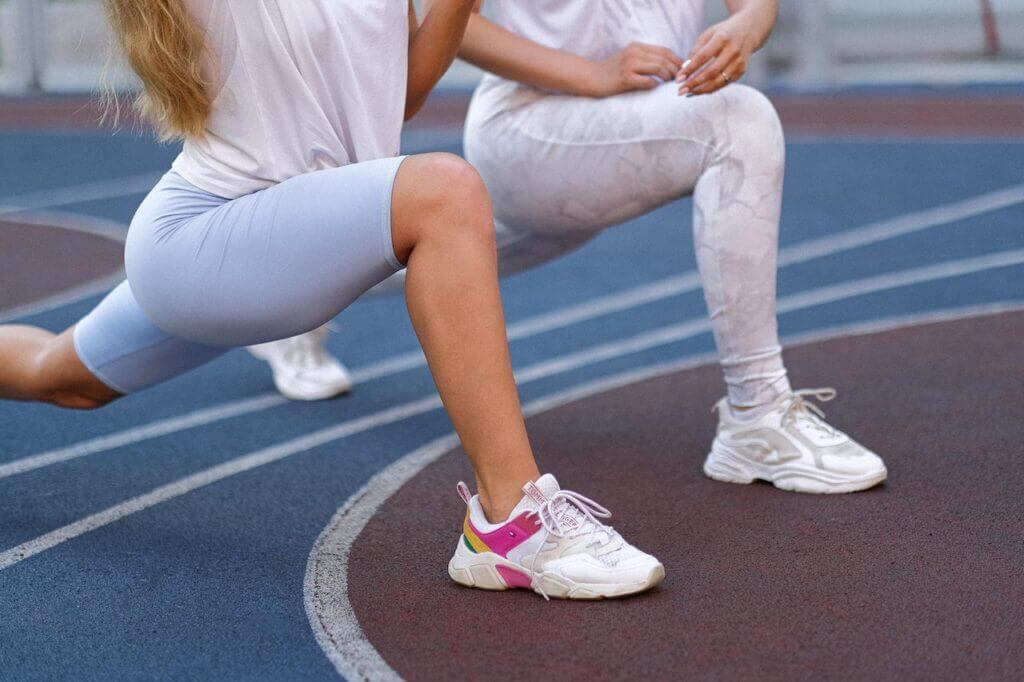Ready to leave your competition in the dust? Imagine running effortlessly, gliding with unrivaled speed and power. It’s time to unlock the secret behind running greatness: hip extension. In this guide, we’ll reveal how mastering hip extension can transform your running experience, helping you achieve new levels of performance and leaving others in awe.
The hip extension might sound complicated, but it’s your ultimate running weapon. It’s the key to unlocking hidden potential and propelling yourself forward like a force of nature. By tapping into the power of your hip muscles, you’ll extend your stride, boost your speed, and conquer every race with confidence.
But here’s the catch: most runners are missing out on the incredible benefits of hip extension. They’re settling for mediocrity while you have the chance to excel. Through this guide, we’ll unravel the secrets of hip extension, guide you in assessing your own abilities, and equip you with exercises and techniques to unleash your full running potential.
Get ready to revolutionize your running game. From understanding the mechanics of hip extension to sculpting your body into a running machine, we’ll show you the way. Say goodbye to average and hello to extraordinary as you become a true running powerhouse. Let’s embark on this journey together and unleash the power of hip extension like never before.
Table of Contents
Understanding Hip Extension

A. Definition of Hip Extension and its Role in Running Mechanics
Hip extension is a fundamental movement in which the leg moves backward at the hip joint, propelling the body forward during running. It’s like the forceful push-off that gives you momentum and allows you to cover more ground with each stride. In essence, hip extension is the key to unlocking your running potential.
B. Muscles Involved in Hip Extension During Running
Several muscles work together to achieve hip extension and optimize your running mechanics. These include:
Gluteus Maximus
This is the largest muscle in your buttocks and plays a primary role in hip extension. It contracts forcefully to extend the hip joint, generating power and propelling you forward.
Hamstrings
Located at the back of the thigh, the hamstrings assist in hip extension by controlling the movement of the lower leg. They help maintain balance, stability, and power during the push-off phase of running.
Erector Spinae
Although primarily associated with back extension, the erector spinae muscles in the lower back also contribute to hip extension. They provide stability and support to the spine, enabling efficient transfer of force from the lower body to the upper body during running.
C. Benefits of Proper Hip Extension for Runners
Proper hip extension offers a multitude of advantages for runners. From improved stride length and power to enhance efficiency and injury prevention, it’s a game-changer for your performance. Let’s explore the remarkable benefits of optimizing hip extension in running.
Improved Stride Length and Power
The optimal hip extension allows you to take longer strides, covering more ground with each step. This increased stride length translates into greater speed and power. Think of it as a turbo boost that propels you ahead of the competition.
Enhanced Running Efficiency and Speed
When your hip extensor muscles are engaged and working harmoniously, your running form becomes more efficient. The smooth, fluid motion enables you to conserve energy and maintain a steady pace over longer distances. The efficient hip extension means you can run faster while exerting less effort.
Injury Prevention
Proper hip extension distributes the forces of running more evenly throughout the lower body, reducing the risk of overloading specific muscles or joints. By promoting balanced muscle engagement and movement mechanics, you minimize the chances of common running injuries, such as knee pain, IT band syndrome, and lower back strain.
In summary, hip extension is the driving force behind your running stride. Engaging the gluteus maximus, hamstrings, and erector spinae muscles optimizes your stride length, power, and efficiency, and helps protect against injuries. Understanding the significance of hip extension sets the stage for improving your running performance and taking your abilities to new heights.
Assessing Hip Extension

To improve your hip extension for running, it’s essential to assess your current range of motion. In this section, we’ll explore signs of limited hip extension, self-assessment techniques, and the importance of professional evaluation. By understanding your hip extension capabilities, you can effectively target areas for improvement and optimize your running performance.
A. Common signs of limited hip extension
When it comes to assessing hip extension, it’s essential to understand the common signs that may indicate the limited range of motion or restrictions in this area. Some signs of limited hip extension include:
Reduced stride length
If you find that your strides are shorter than expected or you struggle to take long, powerful steps while running, it could be a sign of limited hip extension.
Decreased running speed
A limited hip extension can impact your running speed, as it restricts your ability to fully utilize the powerful hip extensor muscles. If you consistently struggle to improve your speed despite putting in the effort, it’s worth assessing your hip extension.
Excessive forward lean
An inadequate hip extension can lead to compensatory movements, such as leaning forward excessively while running. This compensatory posture is an attempt to gain extra extension through the lumbar spine rather than the hip joint.
B. Self-assessment techniques for hip extension
To get a preliminary idea of your hip extension range, you can perform self-assessment techniques at home. While these tests are not as accurate as a professional assessment, they can provide valuable insights. Two common self-assessment techniques for hip extension are the Thomas test and the bridge test:
Thomas test
- Lie down on a sturdy surface, such as a table or bed, with your buttocks at the edge and your legs hanging off the edge.
- Bring one knee to your chest and hold it there while allowing the other leg to hang freely.
- Release the knee and let the hanging leg extend backward.
- Observe if your hanging leg rests on the table or if it remains in the air. If it remains elevated, it suggests limited hip extension.
Bridge test
- Lie on your back with your knees bent and your feet flat on the ground, hip-width apart.
- Lift your hips off the ground, engaging your glutes and hamstrings.
- While maintaining the bridge position, attempt to extend one leg straight, keeping it parallel to the other leg.
- Note if you experience any difficulty in maintaining the bridge position or if you feel tightness or restrictions in your hip while extending the leg.
C. Seeking professional help for a more accurate assessment
While self-assessment techniques can provide some initial insights, it’s advisable to seek professional help for a more accurate assessment. A healthcare professional, such as a physical therapist or a sports chiropractor, can perform a thorough evaluation of your hip extension and identify any specific limitations or imbalances.
A professional assessment may involve a combination of physical examinations, movement analysis, and specialized tests to accurately measure your hip extension range and identify any underlying issues. This comprehensive assessment can help tailor a targeted plan to improve your hip extension and address any limitations that may be affecting your running performance.
Remember, seeking professional assistance not only provides a more accurate assessment but also ensures that you receive appropriate guidance and support throughout your journey to better hip extension. Their expertise can help you develop an individualized plan that combines strengthening exercises, mobility work, and corrective techniques to improve your hip extension and enhance your running capabilities.
Exercises to Improve Hip Extension
Ready to enhance your running performance? Let’s explore a range of exercises specifically designed to improve hip extension.
From dynamic warm-ups to targeted drills, these exercises will strengthen your hip extensor muscles, boost mobility, and help you reach new running heights. Get ready to unlock your full potential on the track or trail!
A. Dynamic Warm-up Exercises for Activating Hip Extensor Muscles
Before diving into the main strengthening and mobility exercises, it’s crucial to properly activate your hip extensor muscles through dynamic warm-up exercises. These exercises will fire up your glutes and hamstrings, preparing them for the upcoming workout and helping you achieve optimal hip extension during your run.
Monster Walks
Imagine yourself as a monster on the prowl! Place a resistance band just above your ankles and assume a slight squat position. Step sideways, maintaining tension on the band, and feel the burn in your glutes as you powerfully push off with each step. Keep your core engaged and maintain an upright posture throughout.
Leg Swings
Stand next to a wall or stable support and swing one leg forward and backward in a controlled manner. This exercise activates your hip extensors dynamically and improves your hip mobility. Start with smaller swings and gradually increase the range of motion. Remember to perform swings on both legs to maintain balance and symmetry.
B. Strengthening Exercises for Hip Extensors
Now that your hip extensors are warmed up, it’s time to strengthen them. These exercises target your glutes and hamstrings, enhancing their power and endurance, ultimately leading to a better hip extension during running.
Squats and Lunges
Squats and lunges are classic exercises that engage your hip extensors, among other muscles. Perform squats by lowering your hips back and down as if sitting in an imaginary chair, keeping your knees aligned with your toes.
For lunges, take a step forward, lower your back knee toward the ground, and then push back up. These exercises promote overall lower body strength and stability.
Glute Bridges and Hip Thrusts
Lie on your back with your knees bent and feet flat on the ground, hip-width apart. Squeeze your glutes and lift your hips upward, creating a straight line from your knees to your shoulders. Lower your hips back down and repeat.
To increase the challenge, place a weight or resistance band over your hips. Hip thrusts target your glutes directly, helping to activate and strengthen them.
Romanian Deadlifts
Stand with your feet hip-width apart, holding a barbell or dumbbell in front of your thighs. Keeping a slight bend in your knees, hinge forward at the hips while maintaining a neutral spine. Lower the weights toward the ground while feeling a stretch in your hamstrings.
Engage your glutes and hamstrings to return to the starting position. Romanian deadlifts strengthen the posterior chain, including the glutes and hamstrings, improving hip extension power.
C. Mobility Exercises to Improve Hip Range of Motion
The optimal hip extension requires good mobility in the hip joint. Incorporating these mobility exercises into your routine will help increase your hip’s range of motion, facilitating better extension and reducing the risk of injury.
Hip Flexor Stretches
Kneel on one knee with the other foot planted in front, creating a 90-degree angle. Gently shift your weight forward, maintaining an upright posture, until you feel a stretch in the front of your hip. Hold for 20-30 seconds and switch sides. Repeat this stretch to improve flexibility in the hip flexors, which can restrict hip extension.
Pigeon Pose
Begin in a push-up position and bring one knee forward, placing it behind your hand on the same side. Extend your opposite leg backward, keeping it straight. Lower your upper body onto your forearms or down to the ground, feeling the stretch in your hip and glutes. Hold for 30 seconds and switch sides. The pigeon pose targets the external rotators and glutes, improving the hip range of motion and reducing tightness in the hips.
Deep Squats
Stand with your feet slightly wider than hip-width apart, toes pointing slightly outward. Squat down as low as you comfortably can while keeping your heels on the ground and your chest lifted.
Use your elbows to push your knees out gently, which helps open up the hips. Hold this position for a few seconds and then rise back up. Deep squats improve hip mobility by stretching the hip flexors and increasing hip joint flexibility.
D. Incorporating Hip Extension Drills into Running Workouts
To specifically train and reinforce hip extension during your running workouts, incorporate the following drills into your routine:
High Knees
While running in place, focus on lifting your knees as high as possible while maintaining good posture and engaging your core. The emphasis should be on the upward movement and the activation of your hip extensors. This drill strengthens the hip extensors and enhances your ability to generate power during each stride.
Skipping
Skipping is a fun and effective exercise for promoting hip extension. While skipping, exaggerate the upward knee drive and the extension of your hip and ankle, propelling yourself forward with each skip.
Focus on the powerful push-off from your foot and the extension of your leg behind you. This drill helps develop explosive hip extension and improves running efficiency.
Hill Sprints
Find a moderately steep hill and perform sprints uphill. As you run uphill, your hip extensors have to work harder to propel you forward against gravity. This exercise not only strengthens the hip extensors but also enhances their endurance. Incorporating hill sprints into your training routine challenges your hip extension capabilities and translates into improved running performance on flat terrain.
By incorporating these exercises and drills into your training routine, you’ll not only improve your hip extension but also enhance your overall running performance. Remember to start gradually, listen to your body, and seek guidance from a professional if needed.
Strengthening your hip extensors and improving hip mobility will contribute to better running form, increased speed, and reduced risk of injuries. So, lace up your running shoes, activate those glutes, and get ready to unlock your full running potential with improved hip extension!
Correcting Form and Technique

In order to optimize hip extension and achieve peak running performance, it is essential to focus on correcting your form and technique. By making subtle adjustments, incorporating visualization techniques, and listening to your body’s cues, you can unlock the power of proper hip extension and enhance your overall running experience.
Let’s explore some practical tips to help you fine-tune your running form and maximize your hip extension capabilities.
A. Running form adjustments for optimal hip extension
When it comes to running, proper form is key to maximizing your hip extension and unleashing your full running potential. Here are some adjustments you can make to optimize your hip extension and improve your overall running performance:
Posture
Stand tall and imagine a string pulling you upward from the top of your head. Avoid slouching or leaning forward excessively, as this can restrict your hip extension. Engage your core muscles to maintain stability and alignment.
Hip alignment
Ensure that your hips are in line with your body, neither tilting forward nor backward. Proper alignment allows for efficient hip extension and reduces unnecessary strain on your muscles.
Stride length
Aim for a moderate stride length that allows your hip to extend fully without overreaching. Overstriding can lead to inefficient movement patterns and an increased risk of injury. Experiment with slightly increasing your stride length while maintaining a comfortable and natural rhythm.
B. Cueing and visualization techniques
Mental cues and visualization can play a significant role in improving hip extension and running form. Here are a few techniques to help you enhance your running mechanics:
Focus on driving the knee forward
Imagine your knee leading the way and actively engaging your hip extensor muscles to propel you forward. This mental cue can help you activate and emphasize the hip extension movement.
Visualize a powerful push-off
Imagine that you’re pushing off the ground with force, propelling yourself forward with each stride. Visualizing this explosive push can encourage strong hip extension and boost your running efficiency.
Incorporate imagery of a “tall posture”
Envision yourself running with an upright and elongated posture, with your hips fully extending behind you. Picture yourself effortlessly gliding forward, making the most of each stride.
C. Importance of gradual progress and listening to your body
As you work on improving your hip extension and refining your running form, it’s crucial to emphasize gradual progress and listen to your body’s signals. Here’s why:
Avoiding overtraining and injury
Pushing too hard or making sudden changes to your form can increase the risk of overuse injuries. Gradually introduce form adjustments and allow your body time to adapt to the new movement patterns.
Pay attention to feedback from your body
Each runner is unique, and what works for one person may not work for another. Listen to your body’s signals and adjust your form accordingly. If something feels uncomfortable or painful, it’s essential to address it and make necessary modifications.
Seek guidance when needed
If you’re struggling with improving your hip extension or experiencing persistent discomfort, consider seeking guidance from a running coach or sports professional. They can provide personalized advice, assess your form, and recommend specific exercises or techniques to enhance your hip extension.
Remember, running is a journey of continuous improvement. By gradually refining your form, incorporating cueing and visualization techniques, and being attentive to your body’s needs, you can unlock the full potential of your hip extension and take your running to new heights. Embrace the process, stay consistent, and enjoy the rewards of a stronger and more efficient stride.
Common Mistakes to Avoid
A. Overreliance on Quadriceps and Hip Flexors
When it comes to running, it’s easy to fall into the trap of relying too heavily on your quadriceps and hip flexor muscles while neglecting other essential muscle groups. The quadriceps, located at the front of your thighs, and the hip flexors, which connect your hips and thighs, are indeed important for running. However, overreliance on these muscles can lead to imbalances and hinder your hip extension.
Imagine a seesaw with one side weighted down while the other remains in the air. This is similar to what happens when you overly engage your quadriceps and hip flexors during running. These muscles become overworked and tight, limiting your ability to properly extend your hips and propel yourself forward efficiently.
To avoid this common mistake, it’s crucial to focus on engaging the posterior chain, specifically the gluteus maximus, and hamstrings. These muscles play a significant role in hip extension and help generate power during each stride. By strengthening and activating these muscle groups, you can achieve a more balanced and effective running form.
B. Neglecting Strength Training and Mobility Work

Another mistake runners often make is neglecting strength training and mobility work in their exercise routines. Running alone is not enough to develop an optimal hip extension. While running builds endurance and cardiovascular fitness, it doesn’t necessarily address muscle imbalances or enhance flexibility.
Strength training exercises targeting the gluteus maximus, hamstrings, and other hip extensor muscles are essential for improving hip extension. Squats, lunges, glute bridges, and Romanian deadlifts are excellent exercises that engage these muscles and promote their strength and stability.
In addition to strength training, incorporating mobility exercises into your routine is vital for ensuring a proper hip range of motion. Tight hip flexors and other restricted muscles can limit your ability to extend your hips fully while running. Incorporate hip flexor stretches, pigeon pose, and deep squats to increase flexibility and maintain healthy hip joints.
C. Ignoring Pain or Discomfort
One of the most crucial mistakes to avoid is ignoring any pain or discomfort that arises during or after running. Pain is your body’s way of communicating that something is not right, and ignoring it can lead to more serious injuries or complications.
If you experience persistent pain or discomfort in your hips while running or notice any imbalances in your gait, it’s essential to address the issue promptly. Seek professional advice from a sports physiotherapist or a running coach who can assess your form, guide proper hip extension techniques, and recommend appropriate exercises or modifications to your training routine.
Remember, running should be an enjoyable and rewarding activity. By addressing and correcting these common mistakes, you can improve your hip extension, enhance your running efficiency, and minimize the risk of injury, allowing you to fully enjoy the exhilaration of running to its fullest potential.
Injury Prevention and Recovery Strategies

As a dedicated runner, you understand the importance of staying injury-free and recovering quickly when setbacks do occur. In this section, we will explore essential strategies for injury prevention and recovery that specifically target hip extension issues. By incorporating these practices into your routine, you can keep your hips healthy, improve your running performance, and enjoy a more satisfying running journey.
A. Cross-training and Complementary Exercises
To prevent injuries and support hip extension, cross-training and incorporating complementary exercises into your routine are crucial. Engaging in activities that complement running helps strengthen your muscles in different ways, reduces repetitive strain, and enhances overall body balance.
Consider activities like swimming, cycling, or using an elliptical machine to give your hip extensor muscles a break while still maintaining cardiovascular fitness. These exercises provide a low-impact option that allows your body to recover and adapt. Additionally, including strength training exercises that target the hip extensors, such as kettlebell swings or single-leg deadlifts, can help improve the overall strength and stability of your hips, reducing the risk of injury.
B. Rest and Recovery Techniques
Rest and recovery are often overlooked aspects of training, but they are essential for maintaining healthy hips and preventing overuse injuries. Giving your body enough time to recover between runs allows for tissue repair, reduces inflammation, and replenishes energy stores.
Ensure that you incorporate rest days into your training schedule. These days are not just for physical rest but also mental relaxation. Engaging in activities like yoga, meditation, or gentle stretching can aid in both physical and mental recovery. Proper sleep is another vital component of the recovery process, as it supports tissue repair, hormone regulation, and overall well-being.
Additionally, utilizing recovery techniques such as foam rolling, massage, or contrast baths can help alleviate muscle tension and promote blood circulation, aiding in faster recovery from intense workouts.
C. Seeking Professional Advice for Persistent Issues
While self-care and preventive measures are crucial, it’s important to recognize when it’s time to seek professional advice. If you experience persistent hip pain or limited hip extension despite implementing the aforementioned strategies, consulting with a healthcare professional, such as a sports physician or physical therapist, can provide valuable insight and tailored guidance.
These professionals can assess your specific condition, perform diagnostic tests, and create an individualized treatment plan. They may recommend additional therapies, such as manual therapy techniques, targeted exercises, or specific rehabilitation protocols to address any underlying issues or imbalances. Seeking professional help at the right time can prevent further damage and ensure a safe and effective recovery.
Remember, taking care of your hips and addressing any potential issues promptly not only keeps you running smoothly but also contributes to your long-term running success.
Incorporating cross-training and complementary exercises, practicing rest and recovery techniques, and seeking professional advice when necessary are the pillars of an effective injury prevention and recovery strategy. By prioritizing the health of your hips and maintaining a balanced approach to training, you’ll be able to enjoy your runs and achieve your running goals with confidence and resilience.
Conclusion
Incorporating hip extension exercises into your training routine can be a game-changer for runners. Understanding the importance of hip extension and its role in running mechanics allows you to make targeted improvements that can enhance your performance and reduce the risk of injuries.
By focusing on strengthening the hip extensor muscles, improving mobility, and refining your running form, you’ll experience numerous benefits. Your stride length and power will increase, making you a faster and more efficient runner. Furthermore, the proper hip extension helps distribute the workload across muscles, reducing strain on the quadriceps and hip flexors.
Remember to assess your hip extension regularly, both through self-assessment techniques and professional guidance if needed. Be patient with your progress and listen to your body, gradually incorporating hip extension drills into your running workouts.
Avoid common mistakes such as neglecting strength training and mobility work, and never ignore pain or discomfort. Taking preventive measures and seeking professional advice when necessary can save you from potential setbacks.
Ultimately, hip extension for runners is a holistic approach that goes beyond just improving your running times. It’s about developing strong and balanced hips that support your overall athletic performance and long-term well-being.
So, lace up your running shoes, embrace the power of hip extension, and unlock your full running potential. Embrace the journey, stay consistent, and enjoy the rewards of stronger, more efficient running.


